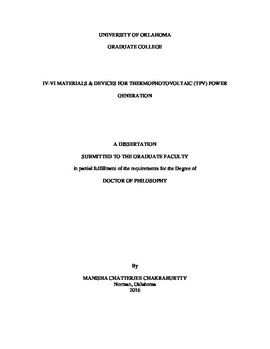| dc.description.abstract | IV-VI semiconductors, with direct gap conduction and valence band extrema at the L-point in k-space, are characterized by four-fold L-valley degeneracy. Prior work [1] has shown that this degeneracy can be removed with quantum confinement in the [111] direction. The first half of this dissertation demonstrates the beneficial effects that this degeneracy removal can have on the performance of thermophotovoltaic (TPV) devices. PbSe quantum wells (QWs) with Pb1-xSrxSe barriers were evaluated. Using Schrodinger’s equation and the two different effective masses for charge carriers in the degeneracy split normal (or longitudinal) L-valley and the higher energy three-fold degenerate oblique L-valleys, the largest possible degeneracy splitting energies for three different normal valley subband energy gaps of 450 meV, 550 meV and 650 meV were found to be 21.7 meV, 37.1 meV, and 43.9 meV, respectively. Intrinsic carrier concentrations were calculated for these QWs using density of states functions and Fermi-Dirac statistics. It was found that thermally generated intrinsic carrier density can be reduced by more than an order of magnitude as compared to that of a bulk IV-VI semiconductor material with the same bandgap energy. Dark current and open circuit voltages for TPV devices made from IV-VI materials were also calculated. Results show that use of optimal QW designs can increase open circuit voltages by almost a factor of two as compared to a bulk material having the same band gap energy. With a doubling of open circuit voltages, the incorporation of QW designs in IV-VI semiconductor TPV devices is predicted to enable a 100% increase in optical-to-electrical power conversion efficiencies.
The second half of this dissertation discusses the experimental results and analysis of data obtained from characterization of pn junction devices fabricated from a bulk Pb0.93Sr0.07Se active layer. The pn junction layer, which consisted of a 2 μm thick n-type layer doped with bismuth to give an electron density of n=4x1018 cm-3 and a 2 μm thick p-type layer with a selenium overpressure during growth to give a hole density of p=4x1017 cm-3, was grown by molecular beam epitaxy (MBE) on silicon, transferred to copper using a novel flip-chip eutectic bonding method, and fabricated into mesa-etched device structures with sizes of 200 x 200 μm2 and 400 x 400 μm2. Current-versus-voltage characterization was performed with and without broadband illumination at different heatsink temperatures to assess the performance of these devices as TPV cells. Measured reverse bias saturation current densities at -26 mV were observed to increase from 7.5 mA/cm2 to 26.9 mA/cm2 as the lattice temperature was increased from 10°C to 50°C. After accounting for band gap temperature dependence and thermal generation effects, these values were consistent with an increase in minority carrier lifetime from 10 ns at 10°C to 100 ns at 50°C. These data show a clear lifetime enhancing thermal re-excitation effect and confirm the high quality of these IV-VI semiconductor epitaxial layer materials for device fabrication applications. Moreover, these data show that high materials quality is maintained during device processing and that there are no significant surface recombination problems with the fabricated device structures. These pn junction devices were also operated at room temperature and in continuous wave (cw) mode as light emitting diodes (LEDs) and as mid-infrared detectors. Representing the first known demonstration of such mid-infrared IV-VI semiconductor device operation, LED emission spectra and detector spectral response showed a bandgap energy of 450 meV (2.76 μm cutoff wavelength) for the MBE-grown Pb0.93Sr0.07Se layer. Broadband illumination measurements were performed with spectrally-filtered thermal radiation and a parabolic optical concentrator (Winston cone). Unlike illumination with a laser, these testing conditions accurately simulate the environment that a TPV cell would experience in an actual TPV generator system. Open circuit voltages as high as 116 mV, short circuit current densities as high as 409 mA/cm2, and fill factors of 43% with an incident optical power density of 620 mW/cm2 were observed. Generated electrical power was greater than 20 mW/cm2 thus giving an optical-to-electrical power conversion efficiency of 3.3% for this non-QW device. External quantum efficiency (EQE) and an estimated internal quantum efficiency (IQE) based on an assumed 40% reflection loss were calculated to be 33% and 55%, respectively. Further optimization of materials growth, device design, and processing techniques as well as incorporation of anti-reflective coatings and use of higher incident optical power densities should ultimately enable power conversion efficiencies in the range of 10% for this bulk material single-junction device. This dissertation concludes with suggestions for how future work can be conducted to take advantage of the unique materials properties of nano-structured IV-VI semiconductors and to use QW materials within multi-junction TPV cell designs to achieve power conversion efficiencies that can be significantly larger than the good values that have already been experimentally demonstrated here.
[1] H. Z. Wu, N. Dai, M. B. Johnson, P. J. McCann, and Z. S. Shi, “Unambiguous Observation of Subband Transitions from Longitudinal Valley and Oblique Valleys in IV–VI multiple Quantum Wells”, Applied Physics Letters 78, 2199 (2001). | en_US |
